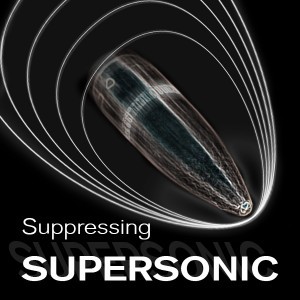January 24, 2016
What is the Supersonic Crack?
After a bullet is fired, it creates pressure waves as air is displaced along its path. Essentially, the air has to move out of the way so rapidly that it's forced to be temporarily compressed. While this pressure wave is created at any speed, it becomes noticeable as a 'crack' once the bullet surpasses the speed of sound (which is approximately 1125 feet per second). At that speed, the pressure waves can't get out of the way fast enough - and they merge together as a 'crack' that travels away from the bullet at the speed of sound.
Unlike the report of the firearm, which has a very specific origination point, the supersonic crack actually originates along the entire path of the bullet - as long as it's traveling faster than the speed of sound.
Because the supersonic crack is traveling with the bullet, it can't be localized the same way a typical gun shot can. Many hog hunters will point out that; although the hogs can definitely hear the crack, they don't know where to run when using a suppressor.
While this pressure wave is created at any speed, it becomes noticeable as a 'crack' once the bullet surpasses the speed of sound (which is approximately 1125 feet per second). At that speed, the pressure waves can't get out of the way fast enough - and they merge together as a 'crack' that travels away from the bullet at the speed of sound.
Unlike the report of the firearm, which has a very specific origination point, the supersonic crack actually originates along the entire path of the bullet - as long as it's traveling faster than the speed of sound.
Because the supersonic crack is traveling with the bullet, it can't be localized the same way a typical gun shot can. Many hog hunters will point out that; although the hogs can definitely hear the crack, they don't know where to run when using a suppressor.
How loud is the Supersonic Crack?
There are lots of factors that impact how loud the supersonic crack is; but, in most of our testing we've found it isn't very loud compared to the report of the firearm. When shooting a suppressed .22, for example, the difference between subsonic and supersonic ammunition is typically only a couple of decibels. There's actually a bigger difference when going from a low-end to a high-end model. (We did this testing with a .22 because it's easy to get ammo that runs just under or over the speed of sound - so we could eliminate other variables.) Having said that, the decibel level doesn't tell the whole story for a couple of reasons:- The supersonic crack is a sharp sound that's typically less comfortable than the 'thud' of a suppressed round. As a result, it often sounds like it's louder than it really is - which has a real impact on whether the shooter feels like they need additional hearing protection.
- Every shooter has a different comfort level when it comes to sound; and, if you're already close to you maximum level the supersonic crack will probably push you over it.
Why is it a Bad Idea to Always Shoot Subsonic Ammo?
While it's true that shooting subsonic ammunition is going to be quieter, it isn't always a good idea for a variety of reasons:- With semi-automatic rifles, such as the AR-15, they typically won't operate correctly unless they have enough blowback. Subsonic ammunition just doesn't have enough pressure to make the rifle run correctly.
- Most barrels are designed with twist rates that are optimized for a specific caliber of bullet travelling at a standard velocity for that caliber. When using subsonic ammunition, the bullet is going far slower - and often won't be stabilized correctly. This has a real impact on accuracy, even at shorter distances.
- Aside from the loss of accuracy, you'll also lose significant range simply because the bullet is traveling slower.
- For hunting or home defense applications, most people prefer to use high-power ammunition that's specifically suited to their purpose. When using a suppressor, you should still use your preferred ammunition so you don't get substandard results - and you'll still be protecting your hearing & situational awareness in the process.





